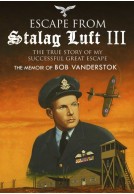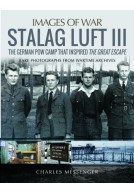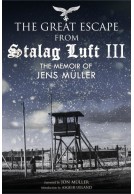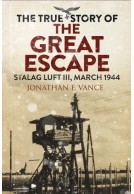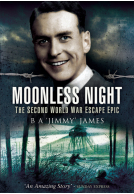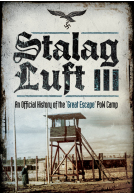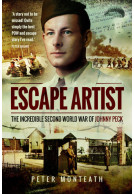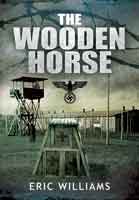
Read exclusive content about the Great Escape via the Pen & Sword blog, including author interviews, giveaways and reviews.
New Titles Published to Mark the 75th Anniversary
Great Escape Memoirs
Escape from Stalag Luft III (Hardback)
The True Story Of My Successful Great Escape
'A born raconteur, his escapes, his operations as a Spitfire pilot, his experiences as a prisoner-of-war, and his incredible escape crossing the Pyrenees – all are described in a breathtaking manner which made me read his book through in one sitting.' Prof Dr L de Jong, Founder/Director of the Dutch Institute for War Documentation'Such a modest man, such a dramatic story – you’ll be pulled into this absorbing account.' Jonathan Vance, The True Story of the Great Escape
"Quickly, I climbed up to the surface and immediately found the rope . . . I felt no signal, so it was not safe yet. Then I felt three distinct tugs and slowly popped my head up. The nearest 'Goonbox' was at least 200 feet away; but, indeed, I was twenty feet from the edge of the woods." Bram Vanderstok
On the night of 24 March 1944, Bram (Bob) Vanderstok was number 18 of 76 men who crawled beyond the barbed wire fence of Stalag Luft III in Zagan, Poland. The 1963 film The Great Escape, made this breakout the most famous of the Second World War: this is the true story of one of only three successful escapees.
Vanderstok's memoir sets down his wartime adventures before being incarcerated in Stalag Luft III and then in extraordinary detail describes various escape attempts, which culminated with the famous March breakout. After escaping, Vanderstok roamed Europe for weeks, passing through Leipzig, Utrecht, Brussels, Paris, Dijon and Madrid, before making it back to England. He reported to the Air Ministry and three and a half months after escaping, on 30 May 1944, he returned to the British no.91 Squadron. In the following months he flew almost every day to France escorting bombers and knocking down V1 rockets.
In August 1944 he finally returned to his home. He learned that his two brothers had been killed in concentration camps after being arrested for resistance work. His father had been tortured and blinded by the Gestapo during interrogation. He had never betrayed his son.
Moonless Night (Paperback)
The Second World War Escape Epic
'An amazing story.' – The Sunday ExpressFrom the moment he was shot down to the final whistle, Bertrand "Jimmy" James' one aim as a POW of the Germans was to escape. The Great Escaper describes his experiences and those of his fellow prisoners in the most gripping and thrilling manner. The author made more than 12 escape attempts including his participation in The Great Escape, where 50 of the 76 escapees were executed in cold blood on Hitler's orders. On re-capture, James was sent to the infamous Sachsenhausen Concentration Camp where, undeterred, he tunnelled out. That was not the end of his remarkable story.Moonless Night has strong claim to be the finest escape story of the Second World War.
The Great Escape from Stalag Luft III (Hardback)
The Memoir of Jens Müller
'The Great Escape was far more than a Hollywood film; it was an aggressive campaign waged by Allied prisoners against the Nazi security forces in their own back yard - and Jens Müller was a key player. His memoir is a must read for anyone interested in this gripping episode of the Second World War.' Simon Pearson, author of The Great Escaper: The Life and Death of Roger BushellJens Müller was one of only three men who successfully escaped from Stalag Luft III in March 1944 - the break that later became the basis for the famous film The Great Escape.
Müller was no. 43 of the 76 prisoners of war who managed to escape from the camp (now in Zagan Poland). Together with Per Bergsland he stowed away on a ship to Gothenburg. The escapees sought out the British consulate and were flown to Scotland. From there they were sent by train to London and shortly afterwards to 'Little Norway' in Canada.
Müller's book about his wartime experiences was first published in Norwegian in 1946, titled, 'Tre kom tilbake' (Three Came Back). This is the first translation into English and will correct the impression - set by the film and Charles Bronson - that the men who escaped successfully were American and Australian.
In a vivid, informative memoir he details what life in the camp was like, how the escapes were planned and executed and tells the story of his personal breakout and success reaching RAF Leuchars base in Scotland.
History of Stalag Luft III
Stalag Luft III (Paperback)
The German POW Camp that Inspired The Great Escape
In early 1942 the Third Reich opened a maximum security Prisoner Of War camp in Lower Silesia for captured Allied airmen. Called Stalag Luft III, the camp soon came to contain some of the most inventive escapers ever known.The escapers were led by Squadron Leader Roger Bushell, code-named 'Big X'. In March 1944, Bushell masterminded an attempt to smuggle hundreds of POWs down a tunnel build right under the noses of their guards. In fact, only 79 Allied airmen clambered into the tunnel and only three made successful escapes.
This remarkable escape would be immortalised in the famous Hollywood film THE GREAT ESCAPE, in which the bravery of the men was rightly celebrated.
Behind the scenes photographs from the film are included in this definitive pictorial work on the most famous POW camp of World War II.
Stalag Luft III (Hardback)
An Official History of the ‘Great Escape’ PoW Camp
Opened in March 1942 to house captured Allied airmen, particularly officers, Stammlager Luft III at Sagan was built to make escape particularly difficult, especially tunnelling. This did not stop the prisoners who dug through more than 100 yards of loose sand, enabling seventy-six men to escape. All but three of the men were recaptured, however, and fifty were executed by the Germans.This Official History of the camp was prepared for the War Office but was never released to the general public. It explains the German administration and running of the camp, the food and conditions the prisoners endured, and the means by which morale was maintained under such trying circumstances. Inevitably considerable space is devoted to the escapes and their careful preparation as well as the anti-escape measures undertaken by the guards. There is also a chapter detailing the punishments meted out for attempting to escape, and lists the number of shooting incidents.
This account provides the reader with an accurate and unprecedented insight into life in a German PoW camp in the latter years of the Second World War.
The True Story of the Great Escape (Paperback)
Stalag Luft III, March 1944
'It shows the variety and depth of the men sent into harms way during World War II, something emphasised by the population of Stalag Luft III. Most of the Allied POWs were flyers, with all the technical, tactical and planning skills that profession requires. Such men are independent thinkers, craving open air and wide-open spaces, which meant than an obsession with escape was almost inevitable' - John D GreshamBetween dusk and dawn on the night of March 24th-25th 1944, a small army of Allied soldiers crawled through tunnels in Germany in a covert operation the likes of which the Third Reich had never seen before.
The prison break from Stalag Luft III in eastern Germany was the largest of its kind in World War II. Seventy nine Allied soldiers and airmen made it outside the wire - but only three made it outside Nazi Germany. Fifty were executed by the Gestapo.
Jonathan Vance tells the incredible story that was made famous by the 1963 film, The Great Escape. The escape is a classic tale of prisoner and their wardens in a battle of wits and wills. The brilliantly conceived escape plan is overshadowed only by the colourful, daring (and sometimes very funny) crew who executed it - literally under the noses of German guards.
From their first days in Stalag Luft III and the forming of bonds key to such exploits, to the tunnel building, amazing escape and eventual capture, Vance's history is a vivid, compelling look at one of the greatest 'exfiltration' missions of all time.







